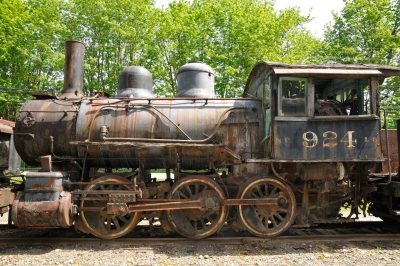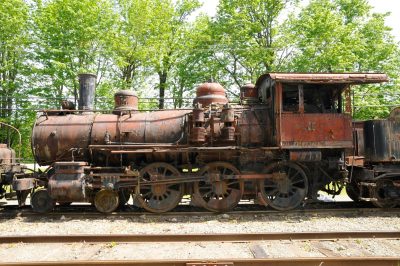 Beginning immediately and over the next two years, the Museum will rehabilitate and restore former Northern Pacific Railway 924, a 0-6-0 (six-coupled) locomotive. Built by Rogers Locomotive and Machine Works in 1899 for the St. Paul and Duluth Railroad as their number 74, the locomotive was renumbered 924 after that road was purchased by the Northern Pacific Railway. In the early 1900s it was Seattle’s King Street Station coach yard switcher, later serving the Seattle and Tacoma yards, and in light branch line service. Sold in 1925 to the Inland Empire Paper Company in Millwood, Washington she remained on their roster until 1969.
Beginning immediately and over the next two years, the Museum will rehabilitate and restore former Northern Pacific Railway 924, a 0-6-0 (six-coupled) locomotive. Built by Rogers Locomotive and Machine Works in 1899 for the St. Paul and Duluth Railroad as their number 74, the locomotive was renumbered 924 after that road was purchased by the Northern Pacific Railway. In the early 1900s it was Seattle’s King Street Station coach yard switcher, later serving the Seattle and Tacoma yards, and in light branch line service. Sold in 1925 to the Inland Empire Paper Company in Millwood, Washington she remained on their roster until 1969.
Canadian Collieries locomotive 14 selected as second.
 Following completion of steam locomotive 924, the Museum will begin the complete rehabilitation of steam locomotive 14, a classic 4-6-0 (“ten-wheeler”) locomotive. The 14 was built by the Baldwin Locomotive Works in 1898 for the Union Colliery Company as their number 4 using the same design developed for the Esquimalt and Nanaimo Railway. When that Vancouver Island mine was absorbed into Canadian Collieries, it was renumbered 14 and continued in service until 1960 when it was purchased by the Museum.
Following completion of steam locomotive 924, the Museum will begin the complete rehabilitation of steam locomotive 14, a classic 4-6-0 (“ten-wheeler”) locomotive. The 14 was built by the Baldwin Locomotive Works in 1898 for the Union Colliery Company as their number 4 using the same design developed for the Esquimalt and Nanaimo Railway. When that Vancouver Island mine was absorbed into Canadian Collieries, it was renumbered 14 and continued in service until 1960 when it was purchased by the Museum.
Making it happen!
The Museum is making a significant commitment to steam by investing in people and facilities. A qualified team of paid and volunteer staff with prior experience in steam locomotive rehabilitation and restoration has been assembled.
The machinery required to perform the work has already been obtained for all aspects of boiler and running gear work. The work will be performed inside the Conservation and Restoration Center, the purpose-built collections care facility opened in 2007 and already equipped with an inspection pit, a monolithic floor, and utilities including sanitary sewer with oil-water separator that allow the Museum to maintain the locomotives in an environmentally responsible manner.
Several major grants and contributions have been pledged and work will begin next week; additional fundraising will be performed during the next 24 months to offset costs that will approach $1 million. Contributions are encouraged and will be used to directly pay for the work performed; they can be made on the Museum’s secure web site here and are tax- deductible to the extent permitted by law.

